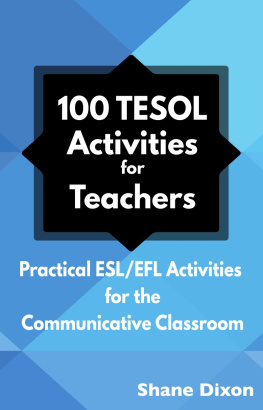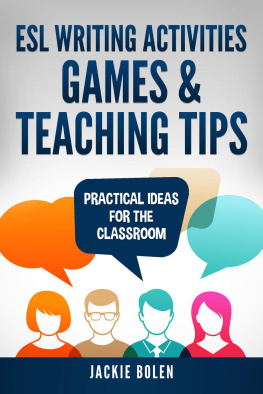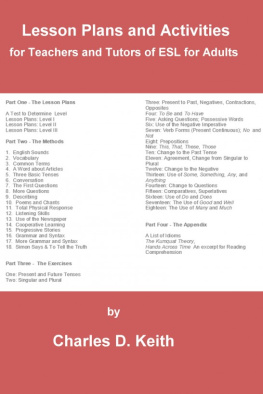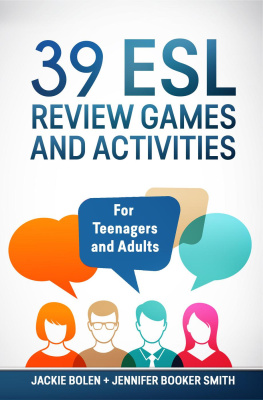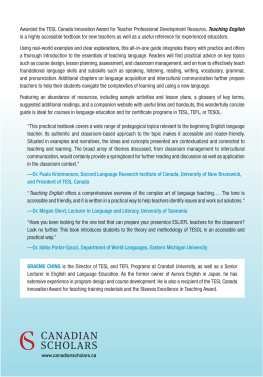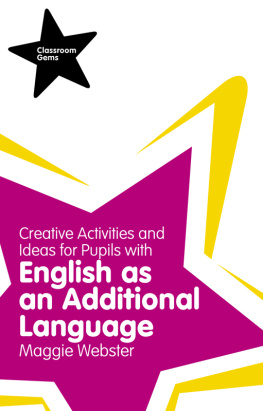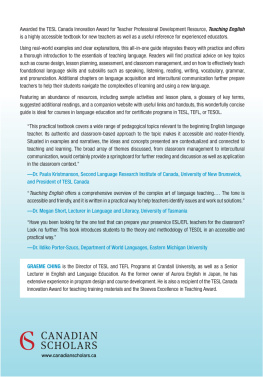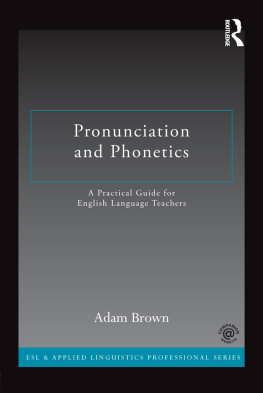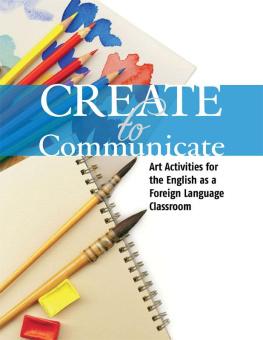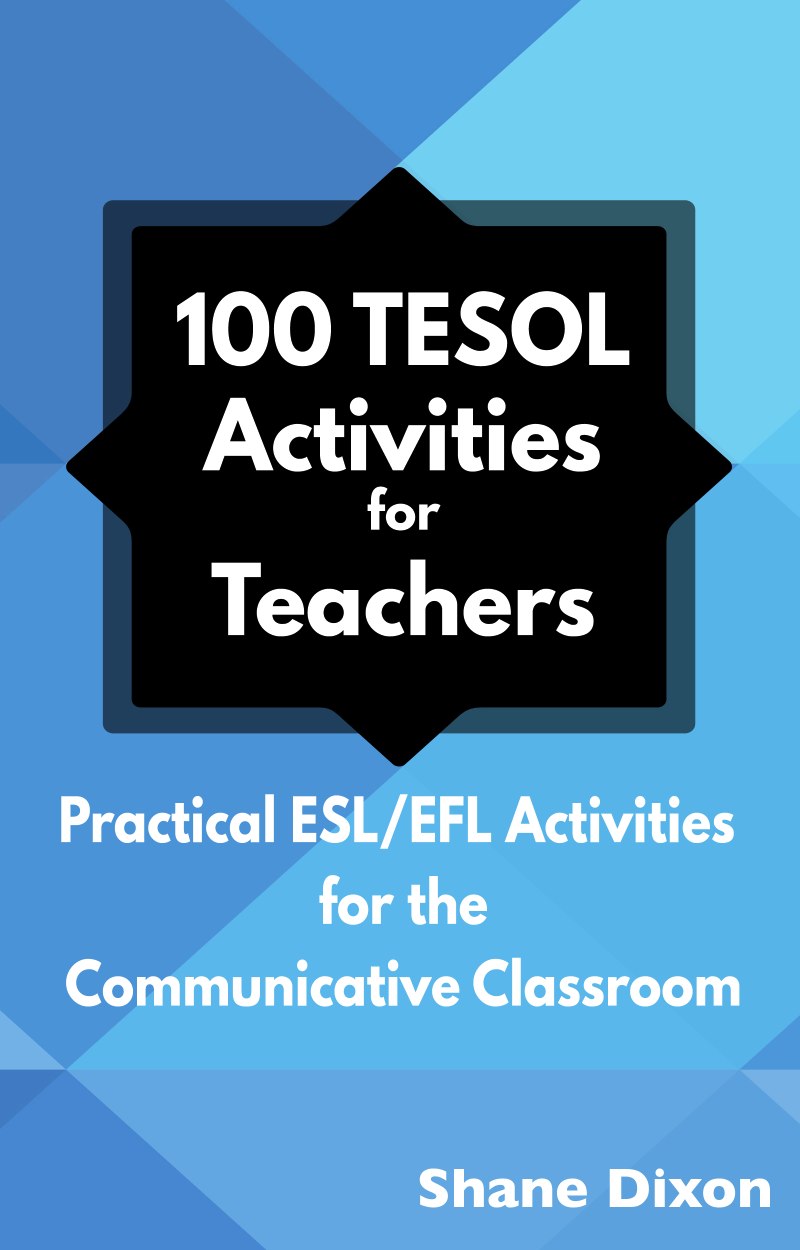100 TESOL Activities for Teachers
Practical ESL/EFL Activities for the Communicative Classroom
Shane Dixon
Contents
C opyright 2016 by Shane Dixon
All rights reserved.
No part of this book may be reproduced in any form or by any electronic or mechanical means, including information storage and retrieval systems, without written permission from the author, except for the use of brief quotations in a book review.
Introduction
T his manual is intended to help give prospective and current Teachers of English to Speakers of Other Languages (TESOL) some of the most common TESOL techniques and strategies recognized and used in the field.
The manual is intended to be practical, and these techniques, for the most part, follow the general need to communicate, interact, and make language come alive in the classroom. Thus, it would be appropriate to state that this manual is aligned most closely to the communicative approach. This is not intended as a pedagogical handbook nor does it attempt a discussion of research-based activities, rather, it simply highlights common practices in the current TESOL classroom. Practitioners are, however, highly encouraged to seek out studies that demonstrate the utility of each and all of these activities both individually and collectively.
The manual is organized into 3 distinct parts.
The first section introduces teachers to some of the most common activities known in English language teaching, starting with a top ten list. What follows are subsections categorized according to the four skills of reading, writing, listening, and speaking.
The second section provides insight into a particular model of lesson planning. This model is the authors alone, although similar models are found throughout the ESL/EFL world. The reasoning behind this model is rather simple. A teacher who can prepare a classroom with organized routines each week is more likely to have success. I have also found that my lesson plans are shaped much more readily when I remember certain steps that I might otherwise forget (take, for example, the need to introduce a theme with a warm-up).
The third section includes printable worksheets that demonstrate realizations of the activities described in the manual. Teachers are free to distribute and copy these for classroom use. You can download a .pdf file of all of the templates at:
http://wayzgoosepress.com/Activitie%20Templates.pdf
You are welcome to use these templates as many times as you like in your own language classrooms. If you have colleagues who would also like to use them, please ask them to purchase their own copy of the book (either paperback or ebook). This will keep the materials affordable for everyone.
I hope you enjoy this small contribution to language learning. May you keep searching for activities that resonate with you and your learners! Any inquiries into this manual can be done by emailing the author at sydixon@hotmail.com.
Happy teaching!
Dr. Shane Dixon
Arizona State University, Spring 2016
Common TESOL Activities
T he most common TESOL activities in the modern classroom are quite different from those of a generation ago. As the communicative approach has grown in both research and pedagogical approach, teachers have continued to discover ways to make the classroom a place of excitement and learning.
The following activities were chosen not only because they are common to the field but because they elicit the kinds of language production that communicative teachers are looking for. These activities tend to cross over the range of student possibilities, meaning that activities can be adapted for all students, from beginning to advanced, and from children to adults.
This does not mean that every activity is necessarily an appropriate activity in the context that you find yourself. However, by reading through these activities, you are encouraged to explore how you might use and modify at least some of these activities so that you are more successful in your English classroom.
Top Ten TESOL Activities
. Information Gap
Information gap is a term used to describe a variety of language activities with one common feature. In essence, an information gap activity uses as its premise the idea that one person or group of people has information that others do not have. Thus, the point of an information gap activity is to have people interact with each other in an attempt to find all the missing information.
For example, imagine that one student has a map with all of the rivers labeled, but all the mountains are unlabeled. Another student has a map with all of the mountains labeled, but not the rivers. A teacher could invite students to share information with each other in pairs with only one simple rule: students with the river map are not allowed to look at the mountain map, and students with the mountain map are not allowed to look at the river map. They must complete their maps with both rivers and mountains by talking with each other and asking questions. This kind of information sharing is referred to as an information gap, and has become a common TESOL technique all over the world.
Here is another simple example. A teacher assigns 10 questions on a piece of paper to student A. Student B is not allowed to view this paper. In contrast, student B is given an article that contains all of the answers to the 10 questions, but student A is not allowed to view the article. Thus, for students to successfully answer all the questions, Student A must ask Student B the questions, and Student B must report those answers to Student A.
Throughout this manual, you will find variations on information gap in order to stimulate conversation. For example, particular information gap activities are:
Im Looking for Someone Who
Interaction Lines
Back to Back Information Gap
Headbands
Reading with Half the Words
. Classic Jigsaw
Jigsaw is a common TESOL reading activity. There are many variations, but in a classic jigsaw, a teacher divides a classroom into four groups (A, B, C, and D). A reading is also divided into four, with one part for each group (so group A reads Part A). The students in each group must read and take notes on each part of the reading. After each group has finished reading the assigned section, students form new groups, with one member from each original group represented (meaning a member of A, B, C, and D all sit down together).
Students now report information to the members of the new group, and every student should take notes on each section of the reading. This gives students a chance to serve both as a reader, a speaker, and a listener, which naturally encourages interaction. Generally, teachers provide questions that the final group must answer, and should monitor each group to provide guidance and answer questions.
. Cloze Passage Exercise
The word cloze is TESOL jargon meaning fill in the blank or missing information. A cloze passage generally has missing words or phrases in the form of a space (____). Students listen to an audio clip, either recorded or spoken, and attempt to fill in the blank with the missing information.
The cloze passage is a popular TESOL activity because it gives students an opportunity to listen to a popular song, conversation, or topic that uses authentic language students can identify with.

